Speciality of Bavaria: Bavaria is Germany’s biggest state. It mixes old traditions with new life in a special way. The town of Berchtesgaden, in the Berchtesgaden Alps near Austria, shows this mix well.
Its Berchtesgaden National Park and the Eagle’s Nest, a former Nazi retreat, show Bavaria’s history. Königssee Lake, Germany’s cleanest, has electric boats since 1909. This shows how Bavaria cares for the environment.
Traditional villages like Schönau am Königssee keep old customs alive. But, they also have modern things for today’s visitors. Bavaria offers both old and new, making it a great place for culture and outdoor fun.
Key Takeaways
- Bavarian traditions and modern life coexist seamlessly in scenic landscapes.
- Berchtesgaden’s Eagle’s Nest and Königssee Lake rank among top places to visit.
- Eco-friendly electric boats on Königssee reflect Bavaria’s early environmental efforts.
- Bavarian history spans royal retreats and modern UNESCO sites like Regensburg.
- Local specialties like smoked trout and festivals like Oktoberfest define Bavarian culture.
Rich History and Cultural Heritage of Bavaria
Bavaria’s heart beats in its festivals, historic sites, and traditions. From medieval parades to rustic village rituals, each celebration tells a story. Travelers can explore both famous spots and hidden gems, diving into its rich heritage.
Traditional Bavarian Festivals
Local festivals like mask dances and Corpus Christi processions keep old traditions alive. Oktoberfest is famous, but villages have smaller events too. Spring and summer are the best times to see these traditions in full swing.
- Pre-Lenten mask celebrations in the southwest
- Corpus Christi processions in Roman Catholic regions
- Annual historic reenactments marking the Thirty Years’ War
Historic Landmarks to Explore
Walk through Nymphenburg Palace’s baroque halls or climb Munich’s Frauenkirche for views. You’ll find St. Peter’s Church, Munich’s oldest, and Marienplatz’s Glockenspiel. Luxury tours offer a mix of history and comfort.
Influence of Bavarian Culture in Modern Times
Traditional dirndls and lederhosen still show up at festivals. Modern designers also wear these styles. Rural towns have their own traditions, showing Bavaria’s heritage is alive. Even Munich’s tech museums show how history meets innovation.
Bavarian Cuisine: A Culinary Delight
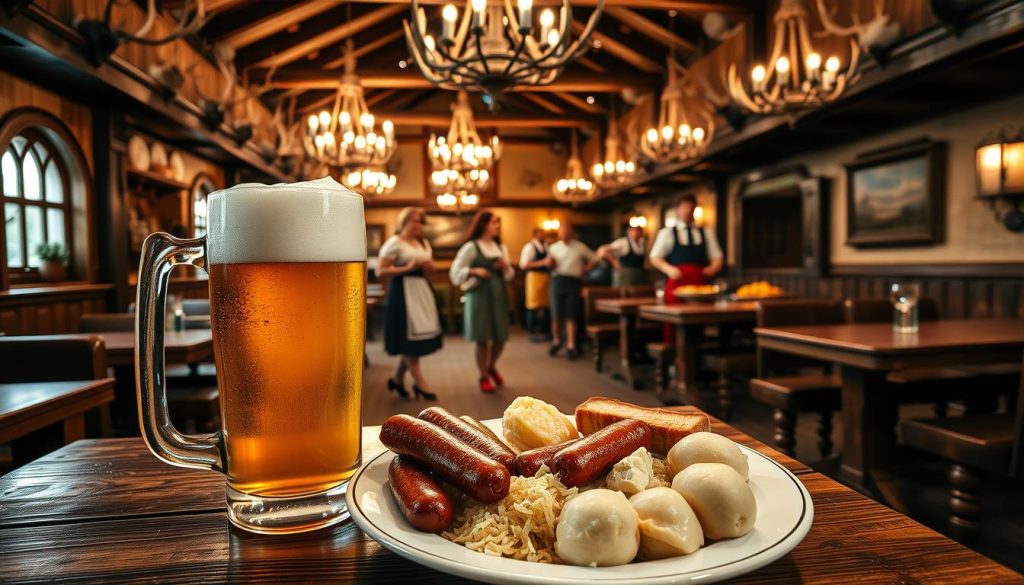
Bavaria’s food is a mix of history and taste. You can enjoy Weisswurst or a cold Bavarian beer. These foods tell stories of the place. You can try them without spending a lot by visiting local markets or beer gardens.
Iconic Dishes to Try
Try Weisswurst, a light sausage, before noon. Eat it with sweet mustard and pretzels at Georgenhof. For a big meal, try Schweinshaxe at Schubecks am Platzl.
Leberkäse, a meaty loaf, is great for lunch at Hofbräuhaus München. These foods are key to Bavarian culture. They often come with local wines or beer.
Famous Bavarian Beers and Breweries
Bavarian beer is made with strict rules. Try Helles lagers or wheat beers at places like Hofbräuhaus. Beer gardens like Chinesischer Turm have cheap beer.
A 4-course meal at Rabenstein Castle’s Castle Menu is special. It pairs Bavarian beer with medieval vibes. It shows you can have a great time without spending a lot.
Sweet Treats: Bavarian Desserts
Finish meals with Apfelstrudel or Dampfnudel. Kaiserschmarrn, a fluffy pancake, is also a must-try. Visit local Konditorei for cheap sweets.
Breath-Taking Natural Landscapes of Bavaria
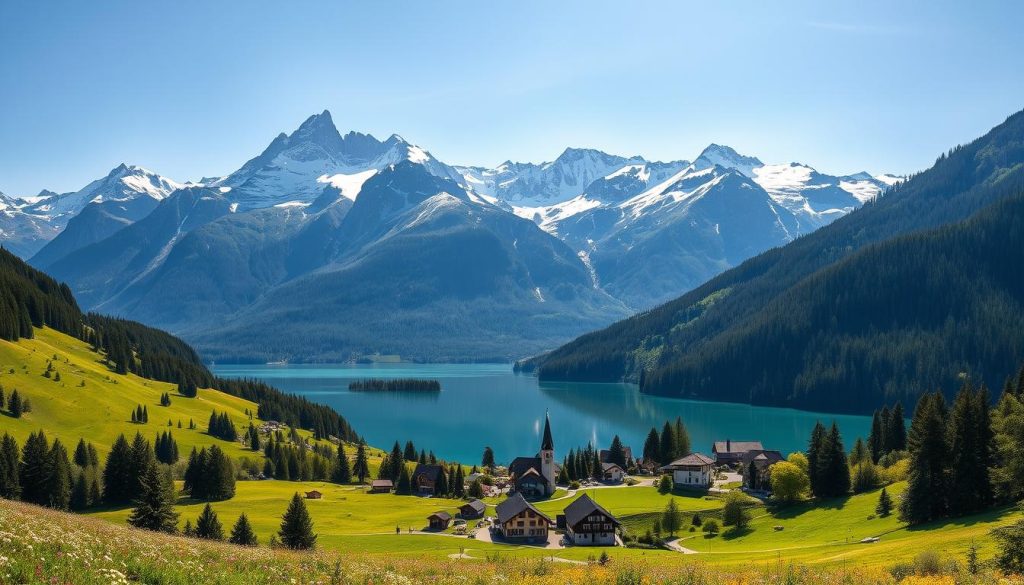
Explore Bavaria’s wild beauty. Mountains, lakes, and forests make it a paradise for outdoor lovers. Hike through alpine meadows or kayak in clear waters. These landscapes inspire endlessly.
The Bavarian Alps: A Mountain Paradise
The Bavarian Alps are at the heart of Bavaria’s wilderness. Peaks like Zugspitze and Watzmann mountain offer stunning views. Trails lead through meadows with edelweiss.
Guided tours help spot ibex and marmots. Don’t miss Neuschwanstein Castle in Hohenschwangau valley. It’s a must-see on any trip.
Picturesque Lakes and Rivers
Bavaria’s waters are clear and beautiful. Königssee is Germany’s cleanest lake. Electric boats glide by St. Bartholomä church.
Chiemsee has palaces, and Starnberger See is great for swimming. Pack light layers and sturdy boots for different climates.
| Lake | Highlight | Activity |
|---|---|---|
| Königssee | Deepest lake in Germany | Boat tours to St. Bartholomä |
| Chiemsee | Home to Herrenchiemsee Palace | Island hikes |
| Starnberger See | Near Munich | Beach relaxation |
Gorgeous National Parks to Visit
Berchtesgaden National Park has ancient pines and valleys. It offers eco-friendly boat tours. Bavarian Forest National Park has trails through primeval woods.
Plan your trip for autumn colors or winter skiing. Pack waterproof gear and reusable bottles for eco-friendly travel.
The Vibrant Cities of Bavaria
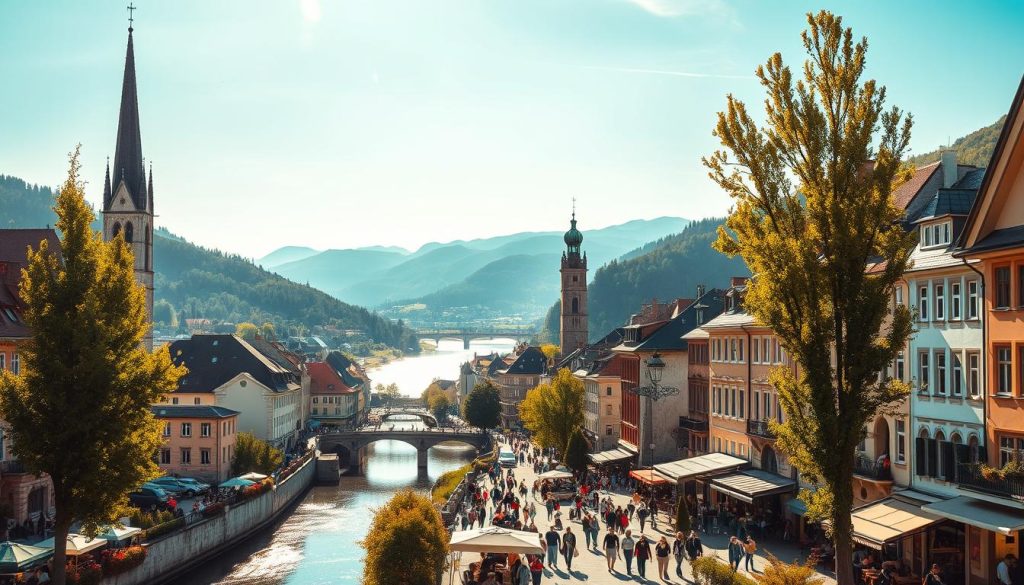
Bavaria’s cities mix old with new, offering fun for all. You can walk Munich’s busy streets or explore Nuremberg’s old alleys. Each place has its own story.
For travelers, where to stay inBavaria depends on what you like. You can find cozy apartments in Munich or historic inns in Regensburg.
Munich: The Heart of Bavaria
Munich’s public transport makes it easy to see sights like Marienplatz and the English Garden. Families enjoy places like Hellabrunn Zoo and the Bavaria Film Studios. To how to plan a trip toMunich, book a place near Marienplatz or the Isar River.
Nuremberg: A City of History
Nuremberg’s old town is full of history and fun. Visit the Imperial Castle and the famous Christmas market. For best travel insurance, choose plans for history and winter fun.
The city’s public transport makes it easy to get to places like the Germanisches Nationalmuseum and the Christkindlmarkt.
Regensburg: A UNESCO World Heritage Site
Regensburg’s streets and buildings are like stepping back in time. Stay in historic hotels near the Stone Bridge. Don’t miss the Gothic St. Peter’s Church.
Planning a trip? Use Regensburg as a base to see nearby family vacation spots like the Danube River cruises.
When visiting Bavaria’s cities, get best travel insurance for safety. Use public transport passes for easy travel. And find the best places to stay to enjoy the region’s cities.
The Arts Scene in Bavaria
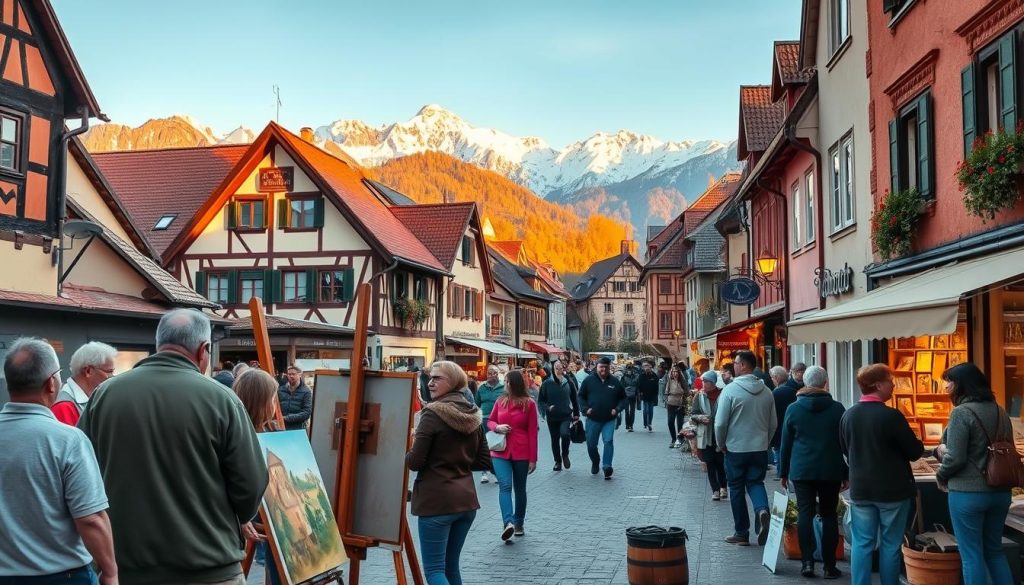
Bavaria’s arts mix old traditions with new ideas. You can see lively folk shows and modern art. It’s a journey for all travelers, perfect for solo explorers or those looking for hidden gems.
Traditional Bavarian Music and Dance
Schuhplattler dances and yodeling fill festivals like the Oberammergau Passion Play. This tradition is over 500 years old. The Bayreuth Festival celebrates Richard Wagner’s operas, attracting people from all over.
Oktoberfest still features alphorns and brass bands. They keep Bavaria’s rural traditions alive.
Prominent Artists from Bavaria
- Richard Wagner’s operas reflect Bavaria’s landscapes and myths.
- Modern artists like Kandinsky found inspiration in Munich’s vibrant art scene.
- Local craftspeople, from woodcarvers to painters, keep ancestral skills alive despite modern pressures.
Museums and Galleries to Discover
Munich’s Sammlung Brandhorst and Kunsthaus München show off modern art. Nymphenburg Palace has exhibitions in its Baroque halls. For those looking for unique experiences, the Deutsches Museum is a must-see.
Visitors should check visa requirements for Germany. Also, explore small town galleries. Bavaria’s arts scene is a mix of tradition and innovation, found in both city museums and village squares.
Oktoberfest: The World’s Largest Beer Festival
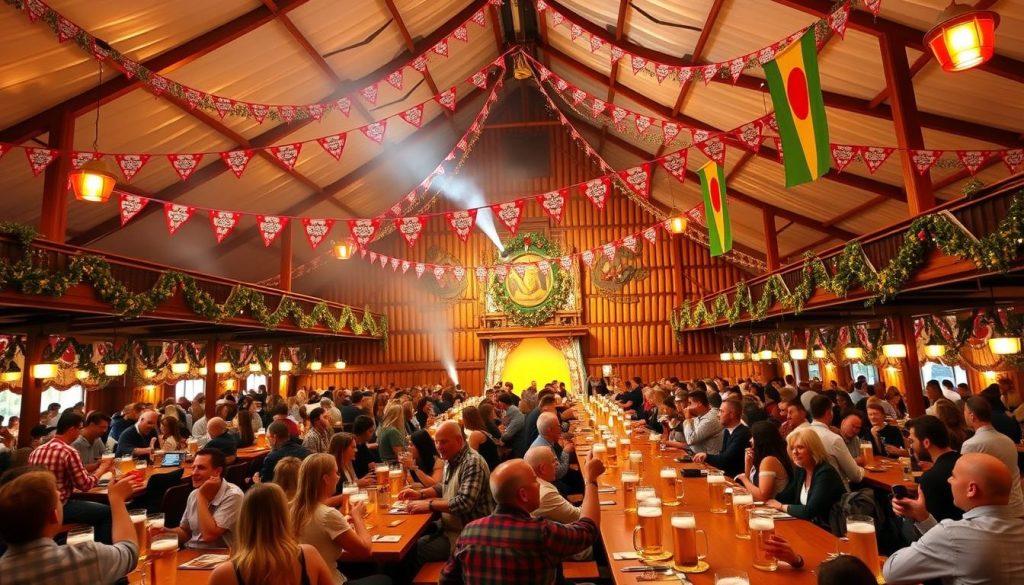
Oktoberfest is in Munich’s Theresienwiese every year. It’s a mix of old traditions and fun. The best time to visit is from September 20 to October 5, 2025. It’s a big deal, with millions coming to celebrate Bavaria’s beer.
Munich is safe, but watch out for travel scams to avoid. Be careful of fake vendors.
It started in 1810 for a royal wedding. Now, it has 14 historic beer tents and over 6 million liters of beer. You’ll find Weisswurst and pretzels everywhere. It’s a big part of Bavarian culture.
There’s live music, rides, and the Oktoberfest opening parade. People wear Dirndls and Lederhosen. You’ll drink Märzen beer in big steins. Try Weisswurst before noon, like the locals do.
- Book accommodations early—hotels fill fast.
- Use public transit or bike rentals for cheap travel tips.
- Stay hydrated and follow local drinking guidelines.
- Verify ticket sources to avoid scams selling fake passes.
Oktoberfest is full of Helles beer and traditional music. It’s a lively way to see Bavaria’s culture. Plan well and enjoy this global event.
Outdoor Activities and Adventure Sports
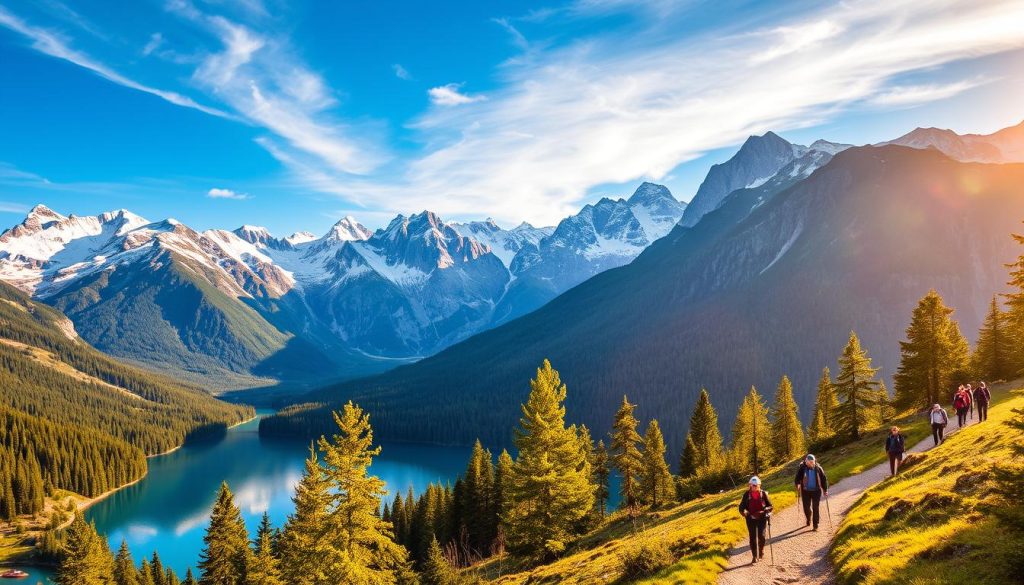
Bavaria’s great outdoors is full of adventure. You can hike, cycle, or ski. It’s all about exploring nature in an eco-friendly way. A travel guide to Bavaria must include these outdoor adventures.
Hiking Trails in the Bavarian Alps
The King’s Way (Königsweg) offers stunning views. The Jenner cable car takes you high up. You can walk by lakes or climb mountains.
Mountain huts along the way offer food and shelter. They mix tradition with green travel. The Königsee area is special, with pine forests and blue lakes.
Cycling Tours Through Bavaria
- Ride the Romantic Road’s bike paths, seeing castles and vineyards.
- Follow the Danube River cycling route, great for families or those who love to exercise.
- Mountain biking in the Bavarian Forest is exciting, with steep descents and greenery.
Many towns have bike rentals and hotels with safe parking. A good tip for cyclists: start early to avoid crowds and enjoy cooler mornings.
Winter Sports: Skiing and Snowboarding
Garmisch-Partenkirchen has world-class slopes. There’s also cross-country skiing and snowshoeing. The best time for winter sports is December to March.
During this time, resorts have festive markets and ice-skating.
| Season | Activity Highlights | Best Time to Visit |
|---|---|---|
| Spring | Wildflower hikes, river kayaking | May-June |
| Summer | Alpine hiking, cycling tours | July-August |
| Winter | Skiing, snowshoeing | December-March |
Speciality of Bavaria has something for everyone, from thrill-seekers to those who love quiet hikes. Use a travel guide to plan your trip. Enjoy Bavaria’s beautiful outdoors and its long history of outdoor activities.
Architectural Wonders of Bavaria

Bavaria’s skyline shows creativity. Castles, Baroque, and modern designs mix together. Each building tells stories of kings, artists, and innovators.
Bavarian Castles: Fairytale Structures
See Neuschwanstein Castle, Ludwig II’s dream castle. It inspired Disney. Also, find Linderhof Palace and Herrenchiemsee, hidden in forests.
These hidden gem destinations offer luxury travel experiences. They mix history and romance.
Gothic and Baroque Architecture
Check out tourist attractions like Regensburg Cathedral. It has tall Gothic arches. Wieskirche has golden Baroque sculptures.
The Wurzburg Residence shines with gold-leaf frescoes. Marienplatz’s Glockenspiel brings medieval life to now. These places show Bavaria’s artistic heart.
- St. Michael’s Church: Romanesque pillars and vaulted ceilings
- Nymphenburg Palace: Baroque gardens and opulent interiors
Modern Architectural Landmarks
Munich’s Allianz Arena lights up with colors. BMW World shows glass curves that mix engineering and art. The Englischer Garten is Europe’s biggest urban park.
These things to do in Bavaria show a mix of old and new.
Conclusion: Why Bavaria Stands Out
Bavaria is special because of its history, traditions, and beautiful landscapes. It has ancient castles and modern festivals. This mix gives travelers a unique experience.
Summary of Bavarian Specialties
Bavaria’s history is deep. Places like Neuschwanstein Castle and Munich’s historic sites show its past. Festivals like Oktoberfest celebrate its traditions.
Its food, like pretzels and marzipan, is a big part of its pride. The Bavarian Alps and Königssee are stunning. Efforts to protect wildlife and forests keep these places beautiful.
Final Thoughts on Visiting Bavaria
Planning a trip? Use a travel guide to find the best spots. Think about the season for your activities. Make sure to pack what you need and get good travel insurance.
Exploring markets in Nuremberg or cycling in rural areas is fun. But, always respect the environment and culture. This way, Bavaria’s magic will stay for everyone. Visit What Is The Specialty Of to know more about speciality of countries worldwide.
